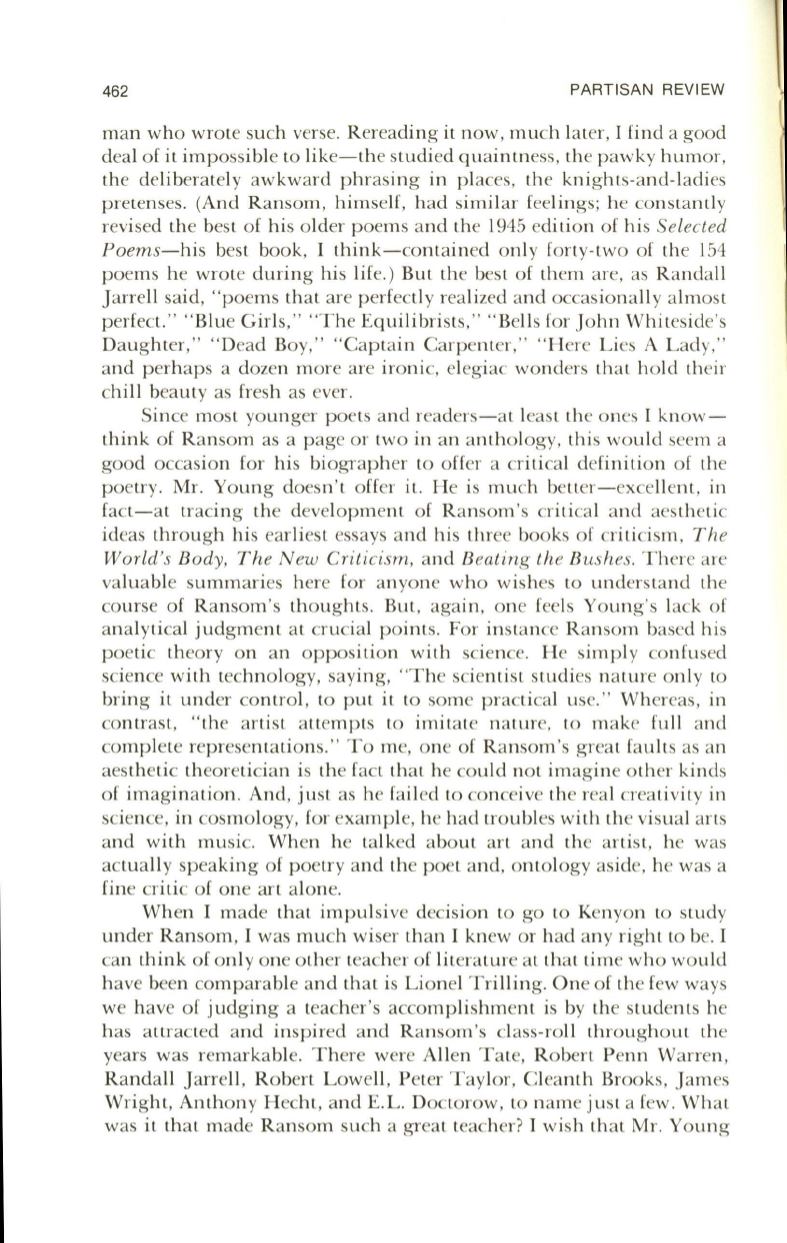
462
PARTISAN REVIEW
man who wro te such verse. Rereading it now, much la ter,
I
find a good
deal of it impossibl e
LO
like-the studi ed quaintness, the pawky humor,
the deliberately awkward ph ras ing in p laces, the kni ghts-and- Iad ies
pretenses. (And Ransom, himself, had simil ar feel ings; he constantl y
revised the best of his older poems and the 1945 edition of hi s
Se lected
Poems-hi s
bes t book,
I
think-contained onl y forty-two of the 154
poems he wrote during hi s life.) But the bes t of them are, as Randa ll
Jarrel l said, " poems tha t are perfectl y rea lized and occas iona ll y a lmos t
perfect. " "Blue Girls," "The Equilibri sts," "Bells for John Whites ide 's
Daughter," " Dead Boy," "Captain Carpenter," " Here Li es A Lady,"
and perhaps a dozen more are ironi c, elegiac wonders tha t ho ld their
chill beauty as fresh as ever.
Since most younger poets and readers - a t leas t the o nes
I
know–
think of Ransom as a page or two in a n antho logy, thi s wo uld seem a
good occasion for hi s biographer to offer a criti cal definiti o n of the
poetry. Mr. Young doesn 't offer it. He is much better-excell ent , in
fact-a t tracing the development of Ransom 's critica l and aes thetic
ideas th rough his earli es t essays and hi s th ree books o f criti cism,
The
World's Body, The New Criticism,
and
Beating the Bushes.
T here a re
valuable summaries here for anyone who w ishes to understand the
course of Ransom 's thoughts. But, aga in , one feels Yo ung's lack of
analytical judgment at crucial poin ts. For instance Ransom based his
poetic theory on an oppos ition with science. He simp ly confused
science with technology, sayin g, "The scientist studies na tu re onl y
LO
br ing it under control , to put it to some p ractical use." Whereas, in
contrast, "the artist a ttemp ts to imita te na ture, to ma ke full and
complete representa ti ons." To me, one of Ransom 's great faults as an
aes thetic theoreti cian is the fact tha t he could not imagine o ther kinds
of imagina tion. And, just as he fail ed to conceive the rea l creativity in
science, in cosmology, for exampl e, he had troubl es with the visual arts
and with music. When he talked about art and the artist, he was
actuall y speakin g of poetry and the poet and, ontology as ide, he was a
fin e critic of one art alone.
When
I
made that impul sive decision to go to Kenyon to study
under Ransom,
I
was much wiser than
I
knew or had any ri ght
LO
be.
I
can think of onl y one other teacher of litera ture at tha t time who woul d
have been comparable and tha t is Li onel T rilling. One of the few ways
we have o f judging a teacher 's accomplishment is by the students he
has a ttracted and inspired and Ransom 's class-roll througho ut the
years was remarkable. T here were All en T a te, Robert Penn Warren ,
Randall J arrell , Robert Lowell , Peter T aylor, Cleanth Brooks, J ames
Wright, Anthony H echt, and E.L. Doctorow, to name just a few . Wha t
was it tha t made Ransom such a great teacher?
I
wish tha t Mr. Yo un g


